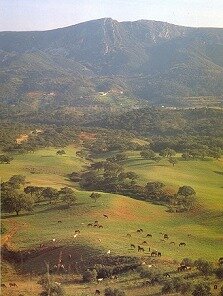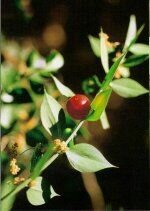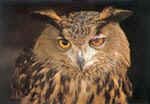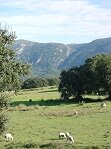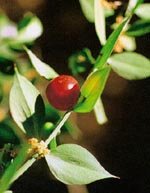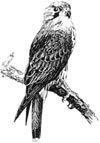|
ARRÁBIDA
MARINE PARK
|

Portugal |
Conservation
status
 |
|
 |
|
Co-ordinates:
38º29’N, 8º57’W
Panorama from
Arrábida Coast. Photo E J
Gonçalves |
Description:
The Arrábida
Marine Park is a 25 Km stretch of
coastline (55 km2)
located on the Portuguese western
shore. Most of the area faces south,
being protected from the prevailing
north and northwest winds by the
adjacent mountain chain of Arrábida.
The shore is very steep and the
intertidal zone includes mainly
rocky cliffs, small beaches and
several areas covered by boulders.
The subtidal begins with a narrow
stretch of rocky substratum that
extends offshore for some tens of
meters, and to depths of less than
15 m (except at the Espichel Cape
area where it reaches more than 40
m). Many large boulders resulting
from the erosion of the nearby
calcareous cliffs increase habitat
complexity. In some places, sandy
beaches interrupt this stretch.
Beyond the rocky substratum, sandy
and muddy bottoms are found.
All
habitats typical of the region are
present, except for intertidal mud
flats. There are a wide range of
different conditions (exposed and
sheltered, sand banks, sandy and
muddy bottoms, highly heterogeneous
rocky habitats, bedrock habitats,
vertical intertidal, seagrass beds).
Only rock pools are limited to a few
locations due to the vertical
orientation of the cliffs.

The strategic
position of the Arrábida Marine Park
makes it an ideal laboratory for
studies on marine biodiversity and
climate change. The shore north and
south from the site is mainly
composed of sandy bottoms, which
gives this site the characteristics
of a “continental island”. The main
orientation of the shore (facing
south) allows many organisms that
only occur in sheltered places to
thrive in the exposed western shore
of Portugal. This is also an
important biogeographic transition
zone of the Lusitanian biogeographic
province, which gives it a high
importance for monitoring purposes.
This area can be regarded as a
marine biodiversity hotspot both at
national and at European level. It
is at the same time an important
leisure place during the summer with
a great potential for environmental
education due to an increasing
public awareness of the great
natural value of the region. This
nature park (land and sea) is
currently being proposed as an
UNESCO World Heritage Site and was a
“Gift to the Earth” by the
Portuguese government through WWF in
the International Year of the Oceans
(1998).
Description of fauna and flora:
During late
spring and summer, dense algae beds
are present in many places, ranging
from dense tufts of Asparagopsis
armata, to some brown algae like
Cystoseira usneoides and, in
some sites, Saccorhiza
polyschides. Encrustating red
algae constitutes biogenic reef
formations in some areas. The
filter-feeding invertebrate fauna is
particularly developed and abundant
in the Marine Park. The marine life
of the Marine Park is relatively
well documented but only for some
groups (macroalgae, fish and some
macroinvertebrates). Over 1000
species of algae, macroinvertebrates,
fish, sea turtles and cetaceans have
been described. Many species present
their distribution limits at or near
the limits of the Marine Park. There
is also a very high occurrence of
rare species and the occurrence of
several Mediterranean species (some
formerly described as Mediterranean
endemics), with some first records
for Portugal. The high diversity of
habitats and of rocky microhabitats
makes this site ideal for
biodiversity studies. In fact, each
time a new group is studied in
detail, many new occurrences for
Portugal are described (some are new
species to science).
Human impact:
There is no known
industrial or agricultural
pollution, mining, dumping or
dredging. The total human population
of the Marine Park is restricted to
Sesimbra village with a population
of 5898 inhabitants with a negative
population growth of 20% from 1991
to 2001. Commercial fishing is
restricted to the nearby waters
(outside the 6 and 12 miles limit).
Inside the marine Park there is
still some traditional fishing using
small gill nets and lobster pots,
and mainly hand lining. The future
management plan for the marine park
proposes a restriction to fishing,
forbidding any fishing activities in
more than 50% of the area and in the
remaining area restricts fishing to
small scale hand lining and lobster
pots. Sport-fishing will be
forbidden.
On-going research:
The Arrábida
Marine Park is the main research
focus of the research line on
Behaviour and Conservation of
Littoral Fishes from the ISPA’s Eco-Ethology
Research Unit. The Nature
Conservancy Institute (ICN) has
statutory responsibility for
managing, monitoring and research on
the Marine Park. There is an
Oceanographic Museum belonging to
ICN which presents a small research
facility. In addition, several
students are also undertaking marine
biological work in the Marine Park.
Facilities:
The area is 45
min. from Lisbon airport and from
our Institute in Lisbon. There is a
medium size harbour in Sesimbra
village and a large size harbour at
Setúbal (10km from the eastern limit
of the Marine Park). There is no
seasonal limitation on access to the
site. Only on rare occasions during
the winter, storms with southern
winds prevent diving. There is an
Oceanographic Museum from the Nature
Conservancy Institute in the area
with a small research facility,
where our group has a diving
operation unit with inflatable boats
with outboard engines. There are a
few rooms to rent near the Museum.
Hotels are available in Sesimbra and
Setúbal and also in the nearby
villages. There are several SCUBA
diving operators in the area
Database available:
All information is being processed
by our group in cooperation with the
Arrábida Marine Park staff (in
particular with the Oceanographic
Museum). Some data are already
available in CD-ROM format, and all
taxa databases are currently being
design by the research team.
Website:
The Arrábida
Marine Park website is under
construction. The ICN website is:
http://www.icn.pt
Commitment:
The ISPA’s Eco-Ethology
Research Unit (research lines:
Ecology and Conservation of Littoral
Fishes and Ecology, Ethology and
Evolution of Aquatic Vertebrates)
has an agreed science plan and
specifically allocated budget for
biodiversity work on the Arrábida
Marine Park with several on-going
projects. The Nature Conservancy
Institute has statutory
responsibility for monitoring NATURA
2000 habitats.
|
